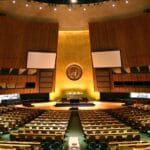Is a nuclear nonproliferation consensus within reach?
By Joshua Pollack | May 3, 2010
Thanks to the participation of Iranian President Mahmoud Ahmadinejad, the eighth conference “to review the operation” of the Nuclear Non-Proliferation Treaty (NPT) is attracting more attention than these affairs usually do. When it concludes on May 28, the NPT Review Conference may not yield a final document expressing the consensus of all 189 NPT member states–but that does not mean the event will be less than spectacular. On only its first day, the conference produced some fireworks.
The Iranians have already come in swinging, apparently determined to obscure their own lawless behavior by challenging the legitimacy of the entire international order.”
Beyond the entertainment value, however, something important is at stake: The spread of sensitive enrichment and reprocessing technologies has weakened confidence in the NPT. New ideas are needed to shore up the treaty. Partly as a result of the emphasis that the Obama administration has placed on nuclear diplomacy, a leadership role will fall to the United States.
As telegraphed in interviews, speeches and policy documents, the American side will call for greater consequences for non-compliance with NPT obligations, an understanding that non-compliance cannot be evaded by withdrawing from the treaty, and recognition of the International Atomic Energy Agency’s (IAEA) Additional Protocol–an agreement providing nuclear inspectors with expanded access necessary to detect undeclared nuclear activities–as “the new international safeguards standard.”
The trick is getting all NPT member states to agree. Review Conferences normally operate on the principle of consensus, meaning that decisions are made unanimously. Because Iran is the only state currently out of compliance with nuclear safeguards, sometimes hints at NPT withdrawal, and declines to ratify the Additional Protocol, it can be expected to stand in opposition.
For that reason, U.S. officials are defining success in terms of whether Iran must go out on a limb alone (or very nearly so) to block consensus. According to Ambassador Susan Burk, the administration’s special representative for nuclear nonproliferation, even if consensus is narrowly denied, the resulting “broad agreement” can be advanced in other forums. How baldly Iran acts to thwart consensus at the Review Conference may also influence the Security Council’s months-long debate over a fourth round of sanctions. The name of the game, therefore, is to isolate what Under Secretary of State Ellen Tauscher has called the “few outliers,” letting them absorb the blame for their own actions.
There are risks to lowering expectations too much; if it is already presumed that there will be no consensus final document, Iran may conclude it will pay no price for obstructionism. The Iranians have already come in swinging, apparently determined to obscure their own lawless behavior by challenging the legitimacy of the entire international order.
Speaking from the lectern at the UN this morning, Iran’s president denounced the United States and the “Zionist regime,” repeated his call to expel America from the Board of Governors of the IAEA, and demanded the reform of the UN Security Council.
After excoriating the possession of nuclear weapons as “disgusting and shameful,” Ahmadinejad observed that possession forces other states to follow suit. Earlier, when IAEA Director-General Yukiya Amano called upon Iran to “clarify activities with a potential military dimension,” C-SPAN’s camera showed Ahmadinejad laughing contemptuously. When it comes to winning over delegations, this undiplomatic conduct probably hurts more than it helps.
But if Iran must bear the albatross of its own president, the United States also carries burdens, some of its own making, and some not. These include unfulfilled pledges from past NPT Review Conferences. First, a resolution in the final document in 1995 called for making the “utmost efforts” to secure a zone free of weapons of mass destruction in the Middle East. For Washington, these efforts start with hammering out a regional peace agreement; but other states, especially Egypt, appear dissatisfied. Second, a resolution in the final document in 2000 called for 13 “practical steps,” including seeking entry into force of the Comprehensive Nuclear Test Ban Treaty (CTBT), which the United States has balked at ratifying. Even if there are no prospects of quick success, the willingness of the American side to reaffirm these commitments will be important.
Another stumbling block is the U.S.-Indian civil nuclear agreement approved by the Nuclear Suppliers Group in 2008. India, which is not a member of the NPT, now can avoid the need to choose between nuclear weapons and access to other countries’ peaceful nuclear technology. The unhappiness of non-nuclear-weapon states over the India deal may be deepened by China’s decision to follow suit by supplying reactors to Pakistan, which–along with Israel and North Korea–also stands outside the NPT.
Fortunately, there are some new cards in the hand of the United States and the other states determined to reinforce the nonproliferation regime. America can now cite a renewed commitment to the principle of nuclear disarmament. The investment in goodwill represented in the “Prague vision,” President Obama’s reaffirmation of the ultimate goal of nuclear disarmament, should not be lightly dismissed; nor can the concrete steps already taken toward that end be ignored.
First, the U.S. Nuclear Posture Review curtailed the role of its nuclear arsenal, forswearing nuclear threats against those non-nuclear weapons states in compliance with their nonproliferation obligations, and ruling out the development of new nuclear military capabilities. Second, the New START treaty re-establishes nuclear arms control and verification measures between the United States and Russia, which together possess the overwhelming majority of the world’s nuclear weapons. The U.S. Senate and the Russian Duma are expected to receive the treaty for consideration this month, during the Review Conference.
These are hopeful signs, and there are more. At the conclusion of the April 2010 Nuclear Security Summit in Washington, DC, a diverse group of 47 countries jointly released a communiqué and work plan committing themselves to do more against the threat of nuclear terrorism. Even this relatively uncontroversial warm-up would have been unimaginable just a couple of years ago. By comparison, Iran’s counter-summit held last month produced only a statement by the chair. Ahmadinejad’s dismissal of nuclear terrorism as a “phony” threat at the UN today hinted at frustration with the outcomes of the two summits.
Still, as mentioned above, consensus at the Review Conference will be hard to come by. The real test of the Obama administration’s nuclear policies will be whether they suffice to midwife a “virtual consensus” that isolates the outliers and builds momentum toward a stronger nonproliferation regime. Even in the best case, that endeavor won’t be completed in a month’s time.
Together, we make the world safer.
The Bulletin elevates expert voices above the noise. But as an independent nonprofit organization, our operations depend on the support of readers like you. Help us continue to deliver quality journalism that holds leaders accountable. Your support of our work at any level is important. In return, we promise our coverage will be understandable, influential, vigilant, solution-oriented, and fair-minded. Together we can make a difference.
Topics: Columnists, Nuclear Weapons















